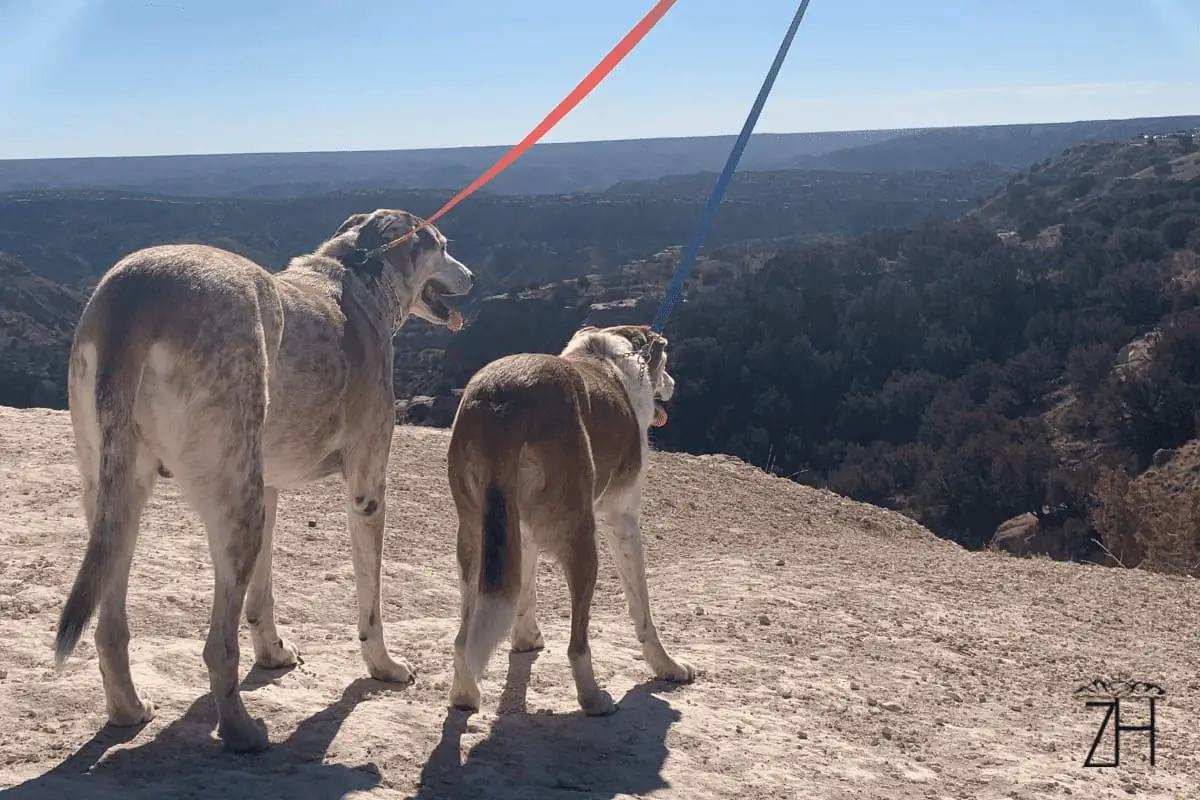There’s no better way to escape the stress of the city than hiking. Breathing in the cool, misty air as you explore the sun-kissed trail ahead—it’s an experience like no other.
Hiking is a wonderful activity to partake with your four-legged best friend. After all, dogs can walk for miles without getting tired. But how far can a dog hike in a day, really?
The answer to this question depends on multiple factors, including your dog’s age, breed, size, hiking experience, and more.
On average, dogs can hike 15 to 30 miles a day. But just because the majority fall under this category, doesn’t mean your dog has the capacity to cover up to 30 miles during your hikes. This is especially true if he’s not used to long-distance walks.
To keep them safe, happy, and comfortable during your hike, you need to accurately determine how far your dog can hike. This article will help you do just that, so read on!
Factors That Impact How Far a Dog Can Hike
To determine how long and how far your dog can hike in a day, there are several factors you have to consider. Like humans, every dog has its own set of physical traits and characteristics. Here are the factors that impact your dog’s hiking capacity.
Age

Young puppies have a lot of playful energy. They love sprinting, running, and jumping around the confines of your home. It’s as if they never tire. But while young dogs love playing, they don’t have that much energy to trek overly long distances.
Here’s the thing: young pups have short legs, small limbs, tiny lungs, and developing bones. These “limitations” prevent them from hiking long trails.
Moreover, young pups are extremely curious. When placed in a new environment, they can’t help but explore their surroundings. Hiking trails are filled with new smells, sounds, and sights; they’re basically Disneyland for dogs! So, you might have a bit of trouble convincing your dog to stay on the trail, thus limiting your progress.
But let’s say your pup doesn’t get distracted. How far can he go? Well, it depends on his age. According to veterinarians, owners must limit their walks to about two minutes per week of age. So, if your pup is 15 weeks old, he can walk for 30 minutes before he gets tired.
Young pups simply don’t have the fitness level to go on long hikes.
Likewise, older dogs can’t spend too much time on their feet. While they love the great outdoors and spending precious time with you, they won’t be able to keep up like they used to.
This is especially true with old dogs with limited mobility and weak joints. Walking great distances is still possible, but you’ll have to take lots of breaks to keep them hydrated and well-rested.
Our Chompers is 16 now and still loves to go out on the trail as much as she always has! However, where we used to go on epic full day hikes, we try to limit our hikes with her now to about an hour or less.
Breed

Some breeds are naturally more accustomed to long walks. These breeds were bred for long hours of work in the great outdoors, regardless of the weather conditions. This makes them the perfect companions for owners with active lifestyles.
For instance, Bernese Mountain Dogs were bred to work long hours outdoors in the cold Swiss Alps. These all-purpose dogs used to herd cattle, pull milk carts to the local dairy, and protect the farm. For this reason, Bernese Mountain Dogs greatly enjoy partaking in strenuous activities like hiking.
According to the American Kennel Club, here are some other fantastic dog breeds for hiking:
- Siberian Husky
- Australian Shepherd
- Portuguese Water Dog
- German Shorthaired Pointer
- Alaskan Malamute
- Vizsla
- Rhodesian Ridgeback
- Australian Cattle Dog
- Weimaraner
- Labrador Retriever
Conversely, some dog breeds simply aren’t fit for hiking activities, regardless of how active or healthy they are.
Short-nosed breeds, for instance, like Shih Tzus, Bulldogs, and Boxers, are susceptible to respiratory issues and thus aren’t suited for long-distance walks. These breeds are known as brachycephalic dogs, a term used to describe breeds with flat faces and shortened snouts.
Now, this isn’t to say that they aren’t allowed to go hiking, or that they’re “bad” runners in general. Far from it. However, they don’t have as much stamina as those who were quite literally bred for the outdoors.
Size

Dogs with short legs—like Basset Hounds, French Bulldogs, and Corgis—don’t cover as much ground as larger dogs.
Since they’re basically running to keep up with your strides, they tire much faster than long-legged dogs.
However, this isn’t to say that they’re less active than large dogs. It really depends on the dog’s breed.
For instance, Beagles (Both of our dogs, Chompers and Mia are beagle mixes) are small but have been bred as hunting dogs for centuries. Their speed and energy trumps that of dogs twice or even trice their size.
However, since they have short legs, they probably won’t cover considerable distances in record time during a hike.
Hiking Experience
Naturally, dogs who sit around all day aren’t as active as dogs who go out for long walks every day.
Like humans, dogs need to be conditioned to hike long distances. Luckily, their physiology is designed for endurance. “Lazy” dogs attain appropriate conditioning levels faster than humans, so you don’t have to wait too long until they’re accustomed to long hikes.
If your dog isn’t used to long-distance hikes, start with a hiking distance of one mile then gradually increase it by half a mile every other day. However, if your dog shows signs of fatigue after the half-mile increase, reduce your next workout distance to a quarter of a mile.
So, for instance, if your last workout was 5 miles and your dog started showing fatigue at 5 1/2 miles, your next session should be 5 1/4 miles.
It’ll take several dozen sessions until your dog reaches his full potential. Just make sure to keep a close eye on his physical state and don’t overwork him to the max.
Weather
Hiking with your dog in poor conditions, especially with heavy rain, intense humidity, and thick fog, snow, or rain affects not only your dog’s hiking distance but yours.
In poor weather, you’ll cover less distance than usual. The hike will also be increasingly difficult and less than enjoyable.
Therefore, for the sake of your and your dog’s safety, always hike in clear weather. Check the weather forecast the day before your hike and just as you leave the house.
If the weather doesn’t stop you, make sure you’re well-prepared for what’s to come. For example, if you’re expecting rain, bring a raincoat for you and your dog. If you’re expecting intense heat, bring an extra pair of bottled water.
Overall Health
Needless to say, healthier dogs have higher energy levels than sickly dogs.
Dogs with pre-existing health conditions, arthritis or hip dysplasia, aren’t suited for long hikes—or at all.
The same is said with dogs that suffer from birth defects like spina bifida and other issues that cause limited mobility. Healthy dogs with recent injuries to bones, muscles, joints, and paws aren’t suited for long hikes until they’re fully healed.
If your dog is susceptible to illness or is suffering from some form of health condition, contact your veterinarian and ask them if you’re allowed to take your dog out for a hike. Once you get the green light from the vet, be sure to follow the precautionary measures they put down.
How to Train Your Dog to Hike Long Distances

Hiking long distances is a gradual process. You can’t just get into it without prior knowledge and experience. You need to physically and mentally prepare yourself to consistently cover far distances without running yourself ragged. The same is said with dogs.
If you’re planning to take your furry best friend on a hike, follow these important tips.
Start Slow
There’s no rush; be patient. As Israelmore Ayivor used to say, “too much haste will make you waste.”
Conditioning your dog for long-distance hikes takes time. Start with short 2-to-3-mile (or even less) hikes and gradually increase the distance by half a mile each session.
On average, it takes a human around 15 to 22 minutes to walk a mile. Healthy dogs should keep up and surpass this pace without any issues.
Also, avoid elevated trails for the first few weeks of training. The steeper the elevation, the harder the hike, resulting in longer breaks. Walk your dog around your local dog park before taking him to a hiking trail. Once he’s ready for the trail, start on flat, easy-to-travel terrain without too many rocks or vegetation.
Don’t Skimp Out on Breaks
This advice is not only for your dog but for you, too. Taking breaks while hiking is extremely important as it allows you to catch your breath and keep hydrated.
In general, you and your dog should take a break every hour or so.
Remember, we have more stamina and endurance than any animal on the planet, including dogs. Therefore, you should be mindful of your dog’s energy levels.
If your dog begins to pant continuously and heavily, slow down and let him rest. The same is said if you notice your dog seeking out areas of shade, as this means he’s getting too hot. Let your dog drink and eat until he feels fit enough to continue your hike.
If your dog seems reluctant to continue even after the break, it’s time to head back.
Be Consistent
When you’re hiking with your pup, rules and routines should remain the same as they are at home. After all, inconsistency breeds unpredictability.
If your dog isn’t allowed to do certain things while at home, he isn’t allowed to do the same on your hikes. You certainly don’t want him testing your patience or acting out and putting his or someone else’s safety in jeopardy.
Whenever your dog responds to a command, reward him like you’d do at home, whether it’s a pat or a treat. This will condition him to follow you regardless of where you are.
Final Thoughts
There you have it; the answer to the question, “How far can a dog hike in a day?”
If your dog is healthy and bred for long-distance walks, he’ll likely be able to hike up to 30 miles per day.
For dogs who aren’t used to hiking, you should probably stick to a maximum of 5 to 10 miles a day. Again, it all depends on your dog’s age, health, breed, and experience.
Happy hiking!

